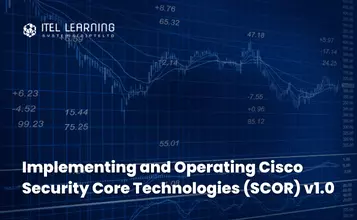Overview
In this course you will learn how to configure your Microsoft 365 tenant, including your organizational profile, tenant subscription options, component services, user accounts and licenses, security groups, and administrative roles. You then transition to configuring Microsoft 365, with a primary focus on configuring Office client connectivity. Finally, you explore how to manage user-driven client installations of Microsoft 365 Apps for enterprise deployments.
Prerequisites
Learners should start this course already having the following skills:
- Completed a role-based administrator course such as Messaging, Teamwork, Security, Compliance, or Collaboration.
- A proficient understanding of DNS and basic functional experience with Microsoft 365 services.
- A proficient understanding of general IT practices.
- A working knowledge of PowerShell.
Who Should Attend?
This course is designed for persons aspiring to the Microsoft 365 Administrator role and have completed at least one of the Microsoft 365 role-based administrator certification paths.
Course Outline
- Explore your Microsoft 365 cloud environment
- Configure your Microsoft 365 organizational profile
- Manage your tenant subscriptions in Microsoft 365
- Integrate Microsoft 365 with customer engagement
apps - Complete your tenant configuration in Microsoft 365
- Determine the user identity model for your
organization - Create user accounts in Microsoft 365
- Manage user account settings in Microsoft 365
- Manage user licenses in Microsoft 365
- Recover deleted user accounts in Microsoft 365
- Perform bulk user maintenance in Microsoft Entra ID
- Create and manage guest users
- Create and manage mail contacts
- Examine groups in Microsoft 365
- Create and manage groups in Microsoft 365
- Create dynamic groups using Azure rule builder
- Create a Microsoft 365 group naming policy
- Create groups in Exchange Online and SharePoint Online
- Plan a custom domain for your Microsoft 365
deployment - Plan the DNS zones for a custom domain
- Plan the DNS record requirements for a custom
domain - Create a custom domain in Microsoft 365
- Examine how automatic client configuration works
- Explore the DNS records required for client configuration
- Configure Outlook clients
- Troubleshoot client connectivity
- Explore the Microsoft 365 permission model
- Explore the Microsoft 365 admin roles
- Assign admin roles to users in Microsoft 365
- Delegate admin roles to partners
- Manage permissions using administrative units in Microsoft Entra ID
- Elevate privileges using Microsoft Entra Privileged Identity Management
- Examine best practices when configuring administrative roles
- Monitor the health of your Microsoft 365 services
- Monitor tenant health using Microsoft 365 Adoption Score
- Monitor tenant health using Microsoft 365 usage analytics
- Develop an incident response plan
- Request assistance from Microsoft
- Explore Microsoft 365 Apps for enterprise functionality
- Explore your app compatibility by using the Readiness Toolkit
- Complete a self-service installation of Microsoft 365 Apps for enterprise
- Deploy Microsoft 365 Apps for enterprise with Microsoft Configuration Manager
- Deploy Microsoft 365 Apps for enterprise from the cloud
- Deploy Microsoft 365 Apps for enterprise from a local source
- Manage updates to Microsoft 365 Apps for enterprise
- Explore the update channels for Microsoft 365 Apps for enterprise
- Manage your cloud apps using the Microsoft 365 Apps admin center
- Examine the analytical features of Microsoft Viva Insights
- Explore Personal insights
- Explore Team insights
- Explore Organization insights
- Explore Advanced insights
- Examine identity models for Microsoft 365
- Examine authentication options for the hybrid identity model
- Explore directory synchronization
- Plan your Microsoft Entra deployment
- Prepare for directory synchronization
- Choose your directory synchronization tool
- Plan for directory synchronization using Microsoft Entra Connect
- Plan for directory synchronization using Microsoft Entra Connect cloud sync
- Configure Microsoft Entra Connect prerequisites
- Configure Microsoft Entra Connect
- Monitor synchronization services using Microsoft Entra Connect Health
- Configure Microsoft Entra Connect cloud sync prerequisites
- Configure Microsoft Entra Connect cloud sync
- Manage users with directory synchronization
- Manage groups with directory synchronization
- Use Microsoft Entra Connect Sync Security Groups to help maintain directory synchronization
- Configure object filters for directory synchronization
- Explore Microsoft Identity Manager
- Troubleshoot directory synchronization
- Manage user passwords
- Enable pass-through authentication
- Enable multifactor authentication
- Enable passwordless sign-in with Microsoft Authenticator
- Explore self-service password management
- Explore Windows Hello for Business
- Implement Microsoft Entra Smart Lockout
- Implement conditional access policies
- Explore Security Defaults in Microsoft Entra ID
- Investigate authentication issues using sign-in logs
- Explore today’s work and threat landscape
- Examine how phishing retrieves sensitive information
- Examine how spoofing deceives users and compromises data security
- Compare spam and malware
- Examine account breaches
- Examine elevation of privilege attacks
- Examine how data exfiltration moves data out of your tenant
- Examine how attackers delete data from your tenant
- Examine how data spillage exposes data outside your tenant
- Examine other types of attacks
- Examine the principles and components of the Zero Trust model
- Plan for a Zero Trust security model in your organization
- Examine Microsoft’s strategy for Zero Trust networking
- Adopt a Zero Trust approach
- Enhance your email security using Exchange Online Protection and Microsoft Defender for Office 365
- Protect your organization’s identities using Microsoft
Defender for Identity - Protect your enterprise network against advanced threats using Microsoft Defender for Endpoint
- Protect against cyber attacks using Microsoft 365 Threat Intelligence
- Provide insight into suspicious activity using Microsoft Cloud App Security
- Review the security reports in Microsoft 365 Defender
- Explore Microsoft Secure Score
- Assess your security posture with Microsoft Secure Score
- Improve your secure score
- Track your Microsoft Secure Score history and meet your goals
- Explore Privileged Identity Management in Microsoft Entra ID
- Configure Privileged Identity Management
- Audit Privileged Identity Management
- Control privileged admin tasks using Privileged Access Management
- Examine the anti-malware pipeline
- Detect messages with spam or malware using Zero-hour auto purge
- Explore anti-spoofing protection provided by Exchange Online Protection
- Explore other anti-spoofing protection
- Examine outbound spam filtering
- Examine the anti-malware pipeline
- Detect messages with spam or malware using Zero-hour auto purge
- Explore anti-spoofing protection provided by Exchange Online Protection
- Explore other anti-spoofing protection
- Examine outbound spam filtering
- Climb the security ladder from EOP to Microsoft Defender for Office 365
- Expand EOP protections by using Safe Attachments and Safe Links
- Manage spoofed intelligence
- Configure outbound spam filtering policies
- Unblock users from sending email
- Protect users from malicious attachments by using Safe Attachments
- Create Safe Attachment policies using Microsoft Defender for Office 365
- Create Safe Attachments policies using PowerShell
- Modify an existing Safe Attachments policy
- Create a transport rule to bypass a Safe Attachments policy
- Examine the end-user experience with Safe Attachments
- Protect users from malicious URLs by using Safe Links
- Create Safe Links policies using Microsoft 365 Defender
- Create Safe Links policies using PowerShell
- Modify an existing Safe Links policy
- Create a transport rule to bypass a Safe Links policy
- Examine the end-user experience with Safe Links
- Explore Microsoft Intelligent Security Graph
- Explore alert policies in Microsoft 365
- Run automated investigations and responses
- Explore threat hunting with Microsoft Threat Protection
- Explore advanced threat hunting in Microsoft 365 Defender
- Explore threat analytics in Microsoft 365
- Identify threat issues using Microsoft Defender reports
- Explore Microsoft Defender Cloud Apps
- Deploy Microsoft Defender for Cloud Apps
- Configure file policies in Microsoft Defender for Cloud Apps
- Manage and respond to alerts in Microsoft Defender for Cloud Apps
- Configure Cloud Discovery in Microsoft Defender for Cloud Apps
- Troubleshoot Cloud Discovery in Microsoft Defender for Cloud Apps
- Explore Microsoft Defender for Endpoint
- Configure Microsoft Defender for Endpoint in Microsoft Intune
- Onboard devices in Microsoft Defender for Endpoint
- Manage endpoint vulnerabilities with Microsoft Defender Vulnerability Management
- Manage device discovery and vulnerability assessment
- Reduce your threat and vulnerability exposure
- Explore the Microsoft Defender for Office 365 protection stack
- Investigate security attacks by using Threat Explorer
- Identify cybersecurity issues by using Threat Trackers
- Prepare for attacks with Attack simulation training
- Explore data governance and compliance in Microsoft Purview
- Protect sensitive data with Microsoft Purview Information Protection
- Govern organizational data using Microsoft Purview Data Lifecycle Management
- Minimize internal risks with Microsoft Purview Insider Risk Management
- Explore Microsoft Purview eDiscovery solutions
- Explore archive mailboxes in Microsoft 365
- Enable archive mailboxes in Microsoft 365
- Explore Microsoft Purview Records Management
- Implement Microsoft Purview Records Management
- Restore deleted data in Exchange Online
- Restore deleted data in SharePoint Online
- Explore retention by using retention policies and retention labels
- Compare capabilities in retention policies and retention labels
- Define the scope of a retention policy
- Examine the principles of retention
- Implement retention using retention policies, retention labels, and eDiscovery holds
- Restrict retention changes by using Preservation Lock
- Examine Microsoft Purview Message Encryption
- Configure Microsoft Purview Message Encryption
- Define mail flow rules to encrypt email messages
- Add organizational branding to encrypted email messages
- Explore Microsoft Purview Advanced Message Encryption
- Explore insider risk management
- Plan for insider risk management
- Explore insider risk management policies
- Create insider risk management policies
- Investigate insider risk management activities and alerts
- Explore insider risk management cases
- Explore Microsoft Purview Information Barriers
- Configure information barriers in Microsoft Purview
- Examine information barriers in Microsoft Teams
- Examine information barriers in OneDrive
- Examine information barriers in SharePoint
- Examine Data Loss Prevention
- Explore Endpoint data loss prevention
- Examine DLP policies
- View DLP policy results
- Explore DLP reports
- Plan to implement Microsoft Purview Data Loss Protection
- Implement Microsoft Purview’s default DLP policies
- Design a custom DLP policy
- Create a custom DLP policy from a template
- Configure email notifications for DLP policies
- Configure policy tips for DLP policies
- Explore data classification
- Implement data classification in Microsoft 365
- Explore trainable classifiers
- Create and retrain a trainable classifier
- View sensitive data using Content explorer and Activity explorer
- Detect sensitive information documents using Document Fingerprinting
- Manage data protection using sensitivity labels
- Explore what sensitivity labels can do
- Determine a sensitivity label’s scope
- Apply sensitivity labels automatically
- Explore sensitivity label policies
- Plan your deployment strategy for sensitivity labels
- Examine the requirements to create a sensitivity label
- Create sensitivity labels
- Publish sensitivity labels
- Remove and delete sensitivity labels








